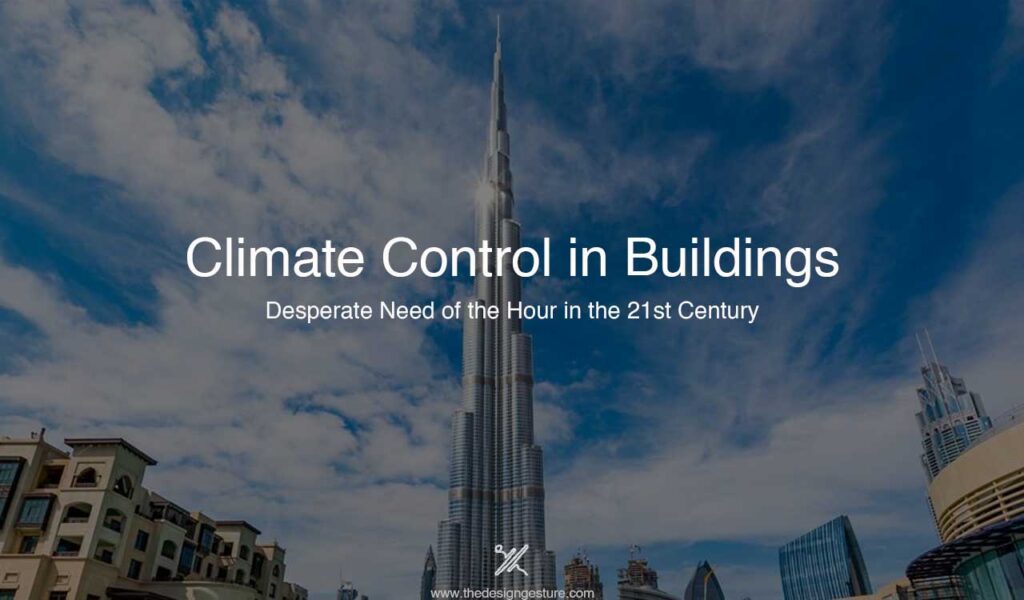Table of Contents
Climate Change
Urbanization is one of the many reasons for climate change. Climate change has become a global concern. It not only changes the temperature outside but also affects other aspects indoors that affect the lifestyle of the people living inside. A region with a naturally hot and humid climate suffers the most when it comes to climate change. It is mandatory to adopt climate control to control the climate. The passive environment of a building can be controlled by HVAC methods, namely heating, ventilation, and air conditioning.
HVAC systems can get pretty expensive. An affordable HVAC system that is efficient and more sustainable is still in development. The architectural design of facades, floor layout, insulating materials for heat absorption, and other naturally occurring climatic circumstances are supposed to be considered for passive environmental optimization of the buildings.
Climate Control in Buildings
Climate control in buildings refers to the optimization of the indoor climate of a particular building according to the user’s needs and demands irrespective of the external climatic conditions, however harsh they may be. The main purpose of climate control is to improve the liveability of a particular place in all aspects.
Significance of Climate Control
Since the entire world is facing global warming, it is necessary for climate control in buildings and homes. This process can get very complicated as well as expensive. Merely inculcating HVAC systems will not be creating a satisfactory effect. Climate control also prevents extreme weather such as heat, or rain. It helps in improving the air quality as well.
Temperature Reduction through Climate Control Strategies
Climate control has gained more importance in recent times as a result of the environmental crisis. The decreased size of apartments gives rise to a less favorable environment indoors. Because of this, keeping the environment in check is of utmost importance. There are different ways to inculcate climate control. Different types of technologies are used for the same.
Artificial Intelligence for Climate Control
The reasons for the need for climate control go beyond the external climatic conditions. Internal factors such as carbon emission are also responsible for it. Appliances such as air conditioners, compressors, televisions, etc. emit carbon footprints. Another aspect that maximizes this effect is the intensity of the heat in the surroundings, both external and internal. Ai helps in the reduction of energy loss by 20%. This helps in creating a better indoor environment. Through the help of sensors, it is possible to track humidity, electricity use, temperature, water flow, and other building functions. The entire system can be tracked through Ai sensors.
Green Technology
Environmental technology, also known as Green technology, affects both internal as well as the external environment. It helps in maintaining a healthy atmosphere and promotes power saving in buildings. HVAC systems, as well as BAS system, help in controlling the internal environment. Green technology not only lowers energy consumption but also is cost-effective. Green technology contributes to the overall development of generating power with the help of wind turbines and other air filtration systems producing renewable energy. Since more and more attention is given to environmental issues recently, sustainability in architecture has seen an increasing interest in the past few years.
Building Materials and Construction Technology
Places are at risk of becoming more and more vulnerable as a result of climate change. Adopting new building materials and construction techniques might help control the passive environment. Materials and construction have an extreme effect on the internal climate. Advanced insulation techniques prevent the internal temperature from getting too hot or cold. Materials like concrete, bricks, and stone absorb a considerable amount of heat.
A reflective roof coating shields the sun’s rays and protects them from invisible rays like UV rays. A lot of materials that are used for coating and preventing the penetration of harmful rays also help in maintaining the indoor climate. Phase-changing materials (PCMs) reduce the carbon dioxide emission in the area. Other aspects, such as thermal mass, can often be ignored, but they are important to consider as a result of climate change. The use of heat pipes is a greenhouse technology used to provide hot and cold water directions at the same level.
Important Climatic Conditions to Consider that Affect the Building
Buildings are subjected to extreme climatic elements such as wind, rain, snow, heat, humidity, etc. As a result, the architecture of buildings or houses changes from place to place as a result of the external climatic conditions. Temperature affects the building materials used for the buildings. The air temperature affects the materials of the building and the soil temperature affects the foundation of the building underground. Humidity is a very important aspect not only for the passive cooling and indoor climate but also for the structural integrity of the materials. Anti-corrosive and water-resistant materials are preferred in areas with higher levels of humidity.
In areas with heavy rainfall, sloping roofs are preferred as opposed to flat roofs, so that the integrity of the structure is not compromised. Sunlight is also an important consideration, as it directly affects the indoor climate. The wall to window ratio changes as per the climate. It increases or decreases according to how warmer or cooler the climate is. The buildings or houses are designed in such a way that it blocks or allow more sunlight indoors. Wind load is considered while designing, since it has destructive capabilities. The building is structurally made sound enough to endure the wind forces.
Architecture and Design
For any climate responsive architectural design, the indoor climate is a major focus. As a result, the architecture and design are important factors in controlling the passive climate. Cross-ventilation can be induced with the help of verandahs and ridge vents. Vernacular architecture can be combined with modern techniques to control the natural climate indoor leading to thermal comfort. Bioclimatic design is another solution, as it combines climate and biology. Positioning windows in such a manner that it allows more airflow is a great way of controlling the indoor climate. External shutters are preferable.
Special paints help in reflecting solar radiation as well as the infrared spectrum. This reduces surface temperature by more than 10 degrees. Window gazing that is spectrally selective let daylight in but keep the heat outside. More thermal mass leads to building materials that absorb and slowly release the heat. This makes the indoor climate cooler in the daytime and warmer at night time. Water combined with natural ventilation can be an excellent cooling mechanism. It absorbs heat, which leads to cooler air being pushed downwards.




